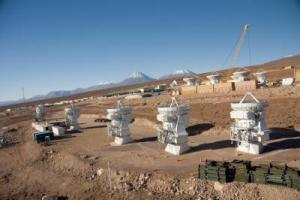By Will Ferguson
Two international research facilities are helping astronomers redefine the bounds of space exploration, without ever leaving the ground.
The new Atacama Large Millimeter/submillimeter Array (ALMA) in Chile and the refurbished Expanded Very Large Array (EVLA) in New Mexico allow researchers to see farther into the universe, with higher clarity, than ever before. Scientists presented some of the facilities’ initial observations Feb. 17 at the American Association for the Advancement of Science meeting in Vancouver.
The images reveal new details of how planets form, how stars arise in other galaxies, and how galaxies themselves developed in the infant universe, said astrophysicist David J. Wilner of the Harvard-Smithsonian Center for Astrophysics in Cambridge, Massachusetts.
“We are now taking images we simply could not take with any other instrument on Earth,” Wilner said. “These two telescopes are the beginning of a new era in astronomy.”
The ALMA operations center in the Atacama Desert, Chile, with four Japanese radio antennas (foreground) and four European antennas (background). Credit: ALMA (ESO/NAOJ/NRAO)
ALMA and EVLA are both arrays of multiple large radio telescopes. ALMA is perched at an altitude of 5,000 meters in the bone-dry Atacama Desert of northern Chile. It is funded by an international partnership of space agencies and is the world’s most expensive ground-based telescope array to date, costing more than $1 billion. It will consist of 66 dishes, each 7 to 12 meters across, upon completion late in 2012.
EVLA sprawls across the plains of Socorro, New Mexico, merging data from 27 separate antennas. The 25-meter antennas are arranged in a giant Y; each arm is about 21 kilometers long. The array is being upgraded with state-of-the-art receivers and electronics.
Both observatories operate in long-wavelength radio frequencies of the electromagnetic spectrum. Those whispers of energy come from deep within cold molecular clouds of hydrogen gas and dust, the birthplaces of planets, stars, and galaxies.
It's difficult for researchers to study these processes with optical and infrared telescopes because little light and heat energy escapes, Wilner said.
“We have to rely on trace constituents like dust, sub-micron-sized particles and trace gases that can show us what is going on in the systems,” he said. “Radio astronomy is really important in this.”
ALMA and EVLA are 10 to 100 times more powerful than any other radio telescopes, Wilner stated. As a result, ALMA can take unprecedentedly detailed photos of a planet forming around a young star more than 100 light-years away. That feat previously would have taken years, with poorer results, he said.
“Although the array isn't yet complete, ALMA [already] is powerful enough to see dust accreting onto young planets and the formation of spiral arms similar to the ones around Saturn,” Wilner said. “You can see these things change practically in real time. It really is extraordinary.”
Physicist and astronomer Christine Wilson of McMaster University in Ontario, Canada, said researchers now use EVLA and ALMA to study distant, colliding galaxies. An international team of researchers has made a string of startling discoveries after only preliminary observations, Wilson noted.
“We have discovered galaxies depleting their star-forming fuel in something like 50 million years, 40 times faster than in normal galaxies,” she said. “The merger of these galaxies has kicked the entire interstellar medium into overdrive, and it's burning up its gas and forming stars incredibly rapidly.”
ALMA and EVLA will allow scientists to study galaxies as distant as 11 billion to 12 billion light-years away, making them the ideal machines to look at the earliest assemblies of stars in the universe, said astronomer Kartik Sheth of the National Radio Astronomy Observatory.
Scientists already have discovered early galaxies forming at a rate 10 or 20 times higher than was thought possible five years ago, he said.
Data from the two arrays will span the full sweep of cosmic time, giving researchers valuable insight into some of astronomy’s greatest unsolved mysteries, Sheth said. “Eventually with our combined efforts, we hope to be able to piece together this puzzle so that we can tell the history of the universe.”
Will Ferguson is a senior journalism major at the University of Arizona. He is a NASA science writing intern for Tucson's daily metro paper, the Arizona Daily Star, and the photo editor for the University of Arizona's student newspaper, the Arizona Daily Wildcat. Reach him at ferguson@azstarnet.com or visit his site at willgferguson.com.

.png)

